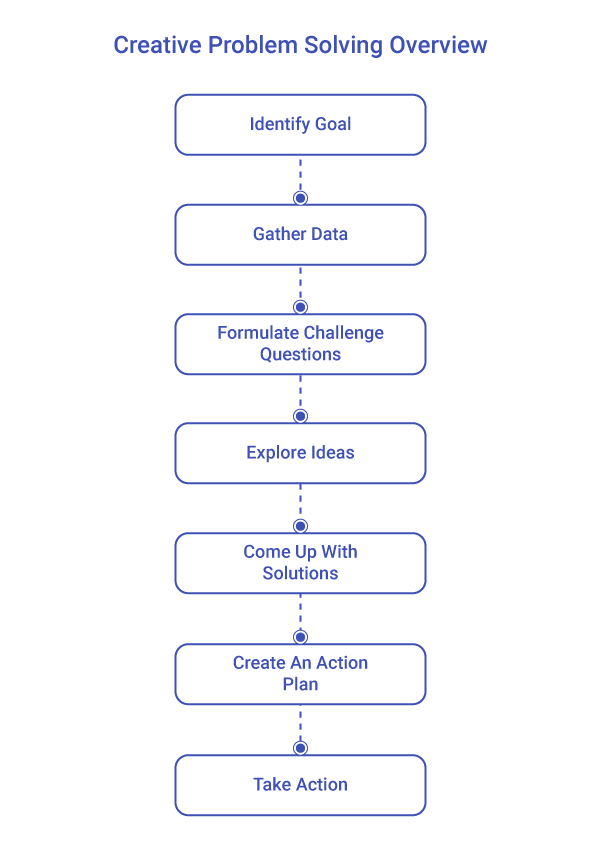
Creative problem-solving (CPS) is a way to solve problems or find gaps when traditional thought fails. It encourages you to come up with fresh perspectives and innovative solutions, so you can formulate a plan to overcome obstacles and achieve your goals.
The creative solution to problems often requires imagination. Creativity is the thinking which drives innovation. Talk about the value of creativity-related business skills has skyrocketed in the last decade. But creativity often does not require creative problem-solving, especially in fields like music, poetry, and art. As a characteristic of what is created, creativity requires newness or novelty, but creativity does not necessarily imply that what is created has value or is appreciated by others.

Creative Problem-Solving Skills – Statistics
1. “Creativity is the single most important skill in the world.” – LinkedIn Learning, January 2019
2. “94% of hiring managers say it is important to consider creativity when hiring a job candidate.”– Adobe, Hiring for the Future (2014)
3. In a search for “creativity in business,” Google returned 345,000,000 results.
4. “35% of workers are only given time to be creative at work a few times per year.” – Gallup 2017 American Workplace Survey
5. “Creative problem-solving sessions with groups that have even a minimal amount of training in creativity tools and principles generated 350% as many ideas than groups without training; these ideas were 415% more original.” – Puccio, et al.
6. “CEOs say creativity is the #1 factor for future success.”– IBM
7. “Recruiters rank creative problem solving as the second most difficult skill to find among job applicants.”– Bloomberg Businessweek
8. “78% of college-educated workers over 25 wish they had more creative ability.”– Adobe, Hiring for the Future (2014).
9. “Countries with high PISA scores have lower confidence in entrepreneurial capabilities.”– Yong Zhao
10. “Creativity is or is related to 9 of the top 10 skills that global executives say is essential for 2020 and beyond.” – World Economic Forum
Stages Of Creative Problem Solving:
- Mess-finding (Objective Finding)
- Fact-finding
- Problem-Finding
- Idea-finding
- Solution finding
- Acceptance-finding
Creative Problem-Solving Helps Businesses
Creative problem-solving lets companies offer their customers creative ideas. It also helps to find new growth prospects in competitive industries. Creative problem-solving as a skill makes you more valuable to prospective organizations.
To be successful in solving problems and improving your problem-solving abilities, you’ll probably need some other main skills, including:
Craftsmanship: Problem-solving is usually either intuitive or systematic. Intuition is used when there is no need for new knowledge-you know enough to be able to make a quick decision and solve the problem or you use common sense or experience to solve the problem. More complex problems or problems that you haven’t experienced before will probably require a more systematic and logical approach to solve, and creative thinking will need to be used for these.
Researching Skills: You also need to do some work to identify and solve problems: this could be a quick Google search or a more detailed research project.
Team working: Through feedback from other team members, several problems are better described and solved. Teamwork may sound like a ‘working thing’ but it’s just as important at home and at school as it is on the job.
The Knowledge in Emotions: It’s worth considering the effect a problem has on you and other people, and/or its solution. Emotional intelligence, the ability to consider yourself and others’ feelings, can help direct you toward a suitable solution.
Managing risks: Solving a problem entails a certain amount of risk, balancing the risk of not solving the problem.
Making Decisions: Problem resolution and decision-making are closely related skills, and decision-making is an important part of the problem-solving process as you are often faced with different options and alternatives.
Thus, creative problem-solving involves an imaginative, innovative, and unconventional approach to a problem. The cycle helps you to discover new, innovative ways of thinking that can help you cope more effectively with the problem at hand. It can be viewed as a learning process in working life. Whatever profession you are in, you’ll be facing challenges and creative problem-solving skills will help you find the best solution to your problem.
Creative problem-solving is also directly proportional to how knowledgeable your workforce is to address complex challenges in day-to-day work. Individuals and enterprise teams getting trained in popular certification training programs across categories such as IT Service Management, Project Management, Agile, DevOps, Quality Management, and IT Security and Governance Courses. By reskilling and upskilling the workforce regularly, it will help enterprises to fully realize their potential and holistically mature in a way that addresses complete digital transformation.
Some of the popular certification courses that individuals and enterprise teams can take up are:














